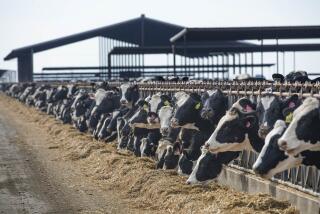AQMD’s Smog Plan for L.A. Basin OKd
- Share via
The California Air Resources Board on Thursday approved the Los Angeles Basin’s controversial smog plan, casting the official blueprint that sets the course of the battle against the nation’s worst air pollution.
Because the scope of its attack on smog is scaled back compared to past efforts, the plan crafted by the South Coast Air Quality Management District was opposed by environmentalists as too weak to assure healthful air.
Rejecting the protests of environmentalists and some businesses during a three-hour hearing, the Air Resources Board voted 8-1 to approve the plan with no modifications.
But in an interview Thursday, board Chairman John Dunlap offered less than a ringing endorsement of the AQMD’s plan, calling the scope, time frame and stringency of the rules “adequate,” but expressing concern that some opposition remained so vigorous.
Fifty-five measures outlined in the plan are scheduled to be enacted over the next four years at a cost estimated by the AQMD at $1.7 billion per year.
The rules are designed to cut emissions in Los Angeles, Orange, Riverside and San Bernardino counties by 61% in 2010 by targeting a variety of pollution sources. Included are restaurant char-broilers, street cleaning, glass manufacturing, water heaters, oil company equipment, idling at truck stops and degreasers used by mechanics and machinists.
Also, national standards for diesel trucks and buses, construction equipment, ships, trains and airliners would be enacted by the U.S. Environmental Protection Agency.
The AQMD board has begun implementing some of the measures. In November, it set rules that gradually ban most house paints that contain oil-based solvents.
The new smog strategy is substantially less aggressive than one adopted by the AQMD and Air Resources Board in 1994. Thirty-one proposals, including rules that would have forced malls and sports arenas to offer rideshare programs, were dropped because the AQMD believed that they were too costly or impractical.
Environmentalists say the plan means a severe rollback in Southern California’s smog control because it allows several hundred additional tons of smog-forming emissions to remain in the air compared to the previous plan. They also say the strategy is overly reliant on undefined clean-air technologies that might emerge after 2005.
Gail Ruderman Feuer of the Natural Resources Defense Council called the Air Resources Board’s decision “a vote to allow decades more of smoggy skies and thousands more premature deaths each year.”
Dunlap, however, said the extensive amount of smog cleanup needed means that the region has to rely on the invention of new technologies.
The AQMD’s plan is designed to clean up enough emissions to bring the Los Angeles Basin into compliance with health limits for ozone and particulates. The two pollutants, which aggravate respiratory problems, are more pervasive and unhealthful in the four-county basin than anyplace in the nation.
The plan will now be sent to the EPA, and if any measures are relaxed or abandoned, the AQMD must make up the shortfall or Southern California faces harsh economic sanctions from the EPA.
The new strategy will probably have to be strengthened in 2002 because the EPA is expected this summer to set more stringent limits on ozone and ultra-fine particles.
Soon after the plan’s draft was unveiled last summer, nine of 11 members of the AQMD’s scientific advisory panel resigned en masse. Several of the advisors said the AQMD’s predictions of future smog was based on flawed computer modeling and that the plan is unlikely to achieve healthful air.
More to Read
Sign up for Essential California
The most important California stories and recommendations in your inbox every morning.
You may occasionally receive promotional content from the Los Angeles Times.










